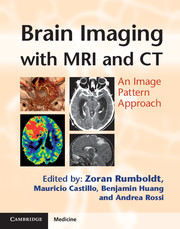Book contents
- Frontmatter
- Contents
- List of contributors
- List of abbreviations
- Preface
- Section 1 Bilateral Predominantly Symmetric Abnormalities
- Section 2 Sellar, Perisellar and Midline Lesions
- 38 Rathke's Cleft Cyst
- 39 Pituitary Microadenoma
- 40 Lymphocytic Hypophysitis
- 41 Pituitary Macroadenoma
- 42 Ectopic Posterior Pituitary Lobe
- 43 Langerhans Cell Histiocytosis
- 44 Craniopharyngioma
- 45 Hypothalamic Hamartoma
- 46 Optic Glioma
- 47 Perisellar Meningioma
- 48 Hemangioma of the Cavernous Sinus
- 49 Tolosa–Hunt Syndrome
- 50 Carotid-Cavernous Sinus Fistula
- 51 Perisellar Aneurysm
- 52 Chordoma
- 53 Chondrosarcoma
- 54 Colloid Cyst
- 55 Aqueductal Stenosis
- 56 Progressive Supranuclear Palsy (PSP)
- 57 Joubert Syndrome
- 58 Rhombencephalosynapsis
- 59 Multiple System Atrophy (MSA)
- 60 Maple Syrup Urine Disease (MSUD)
- 61 Chiari 2 Malformation
- 62 Tectal Glioma
- 63 Brainstem Glioma
- 64 Duret Hemorrhage
- 65 Hypertrophic Olivary Degeneration
- 66 Osmotic Myelinolysis
- 67 Germinoma
- 68 Pineoblastoma
- 69 Pineal Cyst
- 70 Vein of Galen Aneurysmal Malformation (VGAM)
- 71 Corpus Callosum Dysgenesis
- 72 Septo-Optic Dysplasia
- 73 Holoprosencephaly
- 74 Atretic Parietal Encephalocele
- 75 Dermoid Cyst
- 76 Lipoma
- Section 3 Parenchymal Defects or Abnormal Volume
- Section 4 Abnormalities Without Significant Mass Effect
- Section 5 Primarily Extra-Axial Focal Space-Occupying Lesions
- Section 6 Primarily Intra-Axial Masses
- Section 7 Intracranial Calcifications
- Index
- References
69 - Pineal Cyst
from Section 2 - Sellar, Perisellar and Midline Lesions
Published online by Cambridge University Press: 05 August 2013
- Frontmatter
- Contents
- List of contributors
- List of abbreviations
- Preface
- Section 1 Bilateral Predominantly Symmetric Abnormalities
- Section 2 Sellar, Perisellar and Midline Lesions
- 38 Rathke's Cleft Cyst
- 39 Pituitary Microadenoma
- 40 Lymphocytic Hypophysitis
- 41 Pituitary Macroadenoma
- 42 Ectopic Posterior Pituitary Lobe
- 43 Langerhans Cell Histiocytosis
- 44 Craniopharyngioma
- 45 Hypothalamic Hamartoma
- 46 Optic Glioma
- 47 Perisellar Meningioma
- 48 Hemangioma of the Cavernous Sinus
- 49 Tolosa–Hunt Syndrome
- 50 Carotid-Cavernous Sinus Fistula
- 51 Perisellar Aneurysm
- 52 Chordoma
- 53 Chondrosarcoma
- 54 Colloid Cyst
- 55 Aqueductal Stenosis
- 56 Progressive Supranuclear Palsy (PSP)
- 57 Joubert Syndrome
- 58 Rhombencephalosynapsis
- 59 Multiple System Atrophy (MSA)
- 60 Maple Syrup Urine Disease (MSUD)
- 61 Chiari 2 Malformation
- 62 Tectal Glioma
- 63 Brainstem Glioma
- 64 Duret Hemorrhage
- 65 Hypertrophic Olivary Degeneration
- 66 Osmotic Myelinolysis
- 67 Germinoma
- 68 Pineoblastoma
- 69 Pineal Cyst
- 70 Vein of Galen Aneurysmal Malformation (VGAM)
- 71 Corpus Callosum Dysgenesis
- 72 Septo-Optic Dysplasia
- 73 Holoprosencephaly
- 74 Atretic Parietal Encephalocele
- 75 Dermoid Cyst
- 76 Lipoma
- Section 3 Parenchymal Defects or Abnormal Volume
- Section 4 Abnormalities Without Significant Mass Effect
- Section 5 Primarily Extra-Axial Focal Space-Occupying Lesions
- Section 6 Primarily Intra-Axial Masses
- Section 7 Intracranial Calcifications
- Index
- References
Summary
Specific Imaging Findings
Pineal cysts are common and generally less than 15 mm in greatest dimension. When larger, they may compress the tectal plate and aqueduct resulting in hydrocephalus. Pineal cysts usually follow the signal intensity of CSF on T1- and T2-weighted images, occasionally having higher T1 signal. On FLAIR images they are usually brighter than the CSF. The contents are homogenous and follow the CSF on diffusion imaging. Their capsule is thin, less than 2mm in thickness and devoid of nodularity. Cysts may contain internal septations which are also thin. The details of their capsule are more evident with high-resolution volumetric acquisitions and at 3.0 T than at 1.5 T. After contrast administration, the capsule may show linear but never nodular enhancement. The veins around it enhance and may be confused with their capsule. Because they do not have a blood–brain barrier, on delayed post-contrast images they may show fluid levels or enhance in a near-complete fashion, making them difficult to differentiate from solid lesions. When they bleed (pineal apoplexy) they show varying signal intensities corresponding to the age of the blood. Enlarging or decreasing size of the pineal cysts are rare. Pineal cysts are less well seen on CT and a higher percentage of them appear falsely as solid masses.
Pertinent Clinical Information
Pineal cysts are usually incidental findings on imaging studies. It is estimated that up to 40% of the population has them and they are identified by MRI in 7–15% of adults. Pineal cysts usually have no clinical implications and remain asymptomatic for years. Symptomatic cysts vary in size from 7 to 45 mm and they may produce symptoms of headache, vertigo, visual and oculomotor disturbances, obstructive hydrocephalus, and Parinaud syndrome due to compression of the dorsal midbrain. If they acutely bleed internally, they may suddenly enlarge and produce all of these symptoms, which is known as pineal apoplexy.
Information
- Type
- Chapter
- Information
- Brain Imaging with MRI and CTAn Image Pattern Approach, pp. 141 - 142Publisher: Cambridge University PressPrint publication year: 2012
References
Accessibility standard: Unknown
Why this information is here
This section outlines the accessibility features of this content - including support for screen readers, full keyboard navigation and high-contrast display options. This may not be relevant for you.Accessibility Information
- 1
- Cited by
